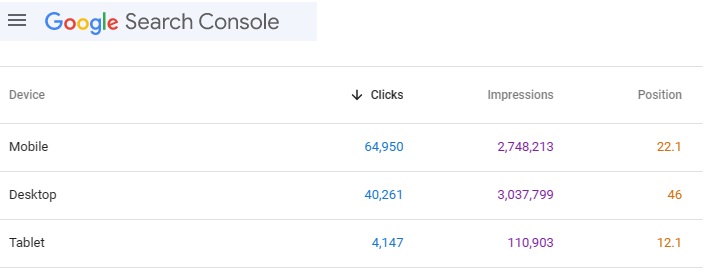Understanding Differences between Desktop and Mobile Rankings
Have you noticed a difference between how your site ranks on desktop browsers vs mobile phones?
You may have better rankings on mobile devices and tablets, or you may be doing better on desktop browsers. A lot of people notice differences but are confounded as to why, or what they could do about it.
It’s an interesting phenomena and gives some nice clues about Google’s ranking algorithm. And depending on your type of business, purpose or product, you may prefer to rank better on one type of device rather than the other.
For example, although more searches and visibility happen on mobile, more B2B sales happen on desktop. But not always. Concert tickets for instance, might be purchased more frequently on mobile phones. The point is that users are doing different things on mobile vs on their laptop/desktop computers. Your analytics should tell you what they’re doing so you can provide the experience appropriate to that device.
Which device would you rather optimize for? Which is creating your leads right now?
Let’s take a quick look at this mobile vs desktop ranking issue now.
Is Speed the Factor?
There’s a few things going on here, but we might conclude quickly that mobile page loading speed is the sole issue.
On a mobile user’s smartphone using the same Wifi connection, the ranking results on Google for mobile and desktop results are the same. That might suggest that page loading times are not the reason why your rankings differ.
On desktop browsers via high bandwidth connections, speed isn’t an issue. However, on a slow 3G connection (which almost no one uses) a slow website is a problem for users. It makes sense that it would rank lower and that faster loading web pages might be able to gain some great rankings. But it’s not always what happens.
You can see the exact opposite of what you’d expect. There must be something else.
Content Not Matching Desktop User’s Intent
Rankings are affected by Google believes each user wants to find and what their intent may be. Some desktop users may be in the bottom of the funnel moment, or a purchase decision. A mobile user might just looking for a location, hours of operation, summary of services like a menu, or info that’s not too deep.
Users on smartphones may not want to dig down into details via that small, hard to read screen. So their user experience is very different from the person who is using a laptop at home with a big screen and a keyboard. The mobile display alone makes it a less desirable user experience. There’s certain things you just won’t get into on a mobile phone, and if you did you would experience fatigue quick enough.
Heavy mobile users also tend to be younger, and they might have different interests such as finding entertainment items like videos and free items. The older desktop user would be looking for different things. They may be considering a high involvement purchase which not be done on a whim on a mobile phone.
Each User has Different Purposes and Needs
Each user has different purposes and that would be reflected in the user’s search history, which Google knows about.
One step ahead of you. Google makes its profit on knowing your search history to present the results you may need next. They know where the user is going next, but does your web page contain that next thing? It’s important to think ahead at what the mobile user would likely want (e.g., service department telephone number, menu pricing, hours of operation, etc.).
When customers call you, what’s the first question they ask? That’s the content you need to put in your page so the mobile user can find it right away. Is your responsive menu easily clickable with their finger so they can get to what they want? If your page is fast and has info ready quick without too many clicks, Google will prefer to show it via mobile search results.
Let’s face it, mobile is not a fun experience due to the use of fingers trying to touch tiny clickable elements and trying to read tiny text. A larger font may be giving you higher mobile rankings.
If your pages/site provide solutions and answers right away, then Google may prefer to show it to users.
You may find mobile ranking increases (as I have) after re-optimizing content and emphasizing specific content on your site. This changes Google’s view of your site’s focus (and target pages). Even though you didn’t change content or quicken page load time, you’ll see a ranking improvement. The fact you forced Google to spider more keyword/topic theme relevant content for mobile users, it likes the change.
Your new linking scheme isn’t about best practices, it’s about giving Googlebot a more focused content experience, and in turn human visitors — matching content to real visitor’s intent.
Therefore, good mobile rankings may show your site’s content is relevant to mobile users, is easily accessed and perhaps written correctly for users (more on that below). This means designing and optimizing for the mobile user experience is wise since Google uses mobile results for rankings.
Having mobile responsive versions of your pages is a must. You may want to consider image-free flat pages which require no server assembly and which load lightning fast. This may give you a big boost in rankings on mobile devices. Google AMP pages are an example of that.
Is the Difference due to the Keyword Phrases?
For sure, keyword phrases do indicate a lot about what users want and what they’ll do on your site. You need to analyze the flow of traffic and determine how successful visitors are in getting what they want. Your content should be slanted toward the keywords your search engine optimization says it’s about. Otherwise, people will leave, giving Google signals of a poor quality experience.
My research doesn’t show any ranking differences when it comes to specific keyword phrases (mobile vs desktop). If there are differences, it’s mostly across all of your keyword phrases. This suggests it is a macro or big picture issue.
This first graphic shows no difference when it comes to a word highly related to purchasing (visitors purchase more via desktop).

And this common keyword phrase about general market information shows mobile has higher rankings.

In my research, mobile vs desktop rankings were generally consistent across all keyword phrases and all web pages. However, you could have one page that’s particularly mobile-optimized and Google might like it a lot.
Your Competitor’s Mobile Experience Sucks
It could be your high mobile rankings happen because your site is better optimized in design and content, vs competitors. You’re benefitting from their lack of excellence in content, poor content flow, low quality content experience, conversion page issues, high bounce rate, slow speed, poor scannability, or their non-responsive web design.
Your web designer and content writer may have put together the right experience, by accident, since branding and sales are their priority, not SEO. That’s good for you, but you can still improve on it!
Strong, Trustworthy Brands to Buy From
Desktop users are looking for stronger brands, trustworthy sites, and complete solutions to actually make a purchase, subscribe, and make decisions. They don’t do that when on the train, subway, or a bus — it’s too risky.
If your desktop rankings are low, it could be the decision and transaction aspect that your competitor’s might be doing well. The desktop user is ready to transact whereas the mobile user wants to find quick and learn basics. They visit fewer pages. You may have the info/learning thing done well, but your site doesn’t look like it’s good for that final act of buying.
Consider elements of trust, proof, validation, and authority being more important on desktop. Business users will be using a desktop browser and are affected by trust factors.
Layout on Desktop Browsers
How your pages appear and what content is included in them can be a factor. For example, if you have material loading into a sidebar section (scripts, ads, interstitials, irrelevant text content and links, etc.), Google may not trust that.
How your site loads into the viewable (above fold) area of the screen could affect whether Google believes it is actually solving the users needs and quest. Your desktop layout might look like a mess to Google. Consider simplifying it with contextual content that is relevant to the main topic or content of that specific page.
What you do with all that screen real estate on big desktop screens is important. Use it well.
Your Bounce Rates are Lower on Mobile
Your mobile pages allow the user to concentrate on your content better. A lack of distractions in the mobile version itself may be a key to why you’re not doing well with your desktop version. Might be time to really simplify your desktop content and layout. Streamline everything so they’ll actually read and experience your excellent main content.
If your user is stickier and less distracted, they may actually progress deeper into your content funnel, which to Google means they’re experiencing more of their buyer journey on your website. On desktop, they might be “shopping” and willing to jump around a lot to cover specific details before purchasing.
Consider what might be ruining the visitor’s content journey and eliminate it.
Lack of Content Depth
Your desktop content might lack the detail, granularity, and coverage that Google believes is necessary. If your competitors have larger sites that cover specific matters better, Google might prefer those sites over yours. If it helps the user be satisfied, learn, engage, resolve concerns, and pave the way for a purchase, then it may be doing its job of creating a new customer better than your site.
Geographic Relevance
If your site is strong in a particular state or country, the location of the user may have an effect. There is an immediacy about mobile listings and Google assumes there is more urgency and they’re looking for a local provider. If you’re strong in the Bay Area of California (your user base, backlinks, and reputation) whereas competitor’s are not located there, then you may enjoy higher rankings on mobile in California (but not in North Carolina or Maine).
In some states or cities you may rank very high, or you may even see more clickthroughs despite your average Google ranking for those keyword phrases being down in the 4th or 5th pages of results.
Headings and Presentation
If you use more headings in the copy, this makes it easier for mobile users to understand what it’s about. Google prefers main ideas stated right away so users don’t waste their time. Meaningful headings make content more consumable.
Decreasing the size of the paragraph, increasing font sizes and clickable links (so they don’t have to finger zoom), and just making your copy easier to read, simpler and more digestible can improve mobile rankings.
Optimizing the User Experience
Google believes the user experience on desktop vs mobile is different and this forces SEOs and content developers to consider the mobile user first — mobile first indexing.
Definitely, your web server should be serving up mobile versions of your page, which might actually leave out some extraneous material that’s in your desktop pages. Higher mobile rankings then might indicate your content is causing problems. Consider removing extraneous content such as big images and content injection.
You might consider installing Google amp to improve page loading speed and letting Google optimize the responsive layout.
Are Users Satisfying their Quest on Your Site?
Google pays attention to the degree the searcher can resolve their quest, whether information or purchase.
More optimizers are paying attention to the bottom of the content funnel for desktop. Those last actions or micro-decision points might play into whether Google will allow your site into the top 20 of a competitive keyword phrase, on desktop rankings.
Perhaps on your site, mobile users accomplish a task, whereas on your desktop version, they lose interest, confidence, and kind of wander away.
Your blog and supporting content might be okay, however your sales and conversion pages might not be providing the results Google wants to see — actual conversion behaviors such as real purchases. So we wonder if a high bounce rate on key marketing/service presentation pages might be hampering rankings, (i.e., on desktop).
Google has stated that your top pages are more important, so you should focus effort more on them. A fast blog section will not save your site, if your core pages are clunky and slow.
Conclusion about Mobile vs Desktop Rankings
So there you have it. Your real rankings are your desktop results and your mobile results reflect your effort to be mobile friendly and satisfy the user experience.
The main point about this is that if most competitor’s websites are not mobile friendly, you may have a chance to rank well on mobile and get more results than you should have gotten. Definitely, make the most of the opportunity.
Your desktop rankings might reflect how well your SEO is going. It could be that too much going on in your pages is not to Google’s liking anymore. Algorithms change according to Google’s business priorities.
So after looking at this issue, don’t forget to return to the key advanced SEO techniques — better, fresher content that generates a completely satisfying user experience in information, impact, trust and bottom of funnel conversions. Google’s watching your site’s ability to satisfy your visitors.
If it isn’t satisfying to those coming in, this may be why you’re having trouble reaching into top ten rankings.
And it may be why people are not linking to your site or sharing your brand and content with their connections.
If this is the case, you’re likely being outcompeted for the top spots. It’s time to invest in content strategy and SEO!
Learn more about advanced SEO and then review some stellar SEO services to help you maximize your free organic presence on the web, and support your social media efforts.
SEO Company | Advanced SEO | Advanced SEO Strategy | Mountain Bike Marketing | California Winery Marketing | Travel Marketing SEO | SEO Services | Bottom of Funnel Optimization | How to Rank High on Google | Advanced Keyword Strategy | 12 Step SEO Strategy | AI SEO Software | SEO Consultant






